Whale Talks
Hello Reader!
I’m a PhD student in the Department of Geography, University of British Columbia. My research focuses on the socio-economic development of Caamano Sound over the last 200 years, with a particular attention to matters of sound. As well as listening to whales, I’ve been reading up on shipping histories, interviewing fellow interns, and trying to wrap my head around the logics of the hydrophone. This ‘report’ offers some preliminary thoughts on my experience as a Cetacea Lab intern (wonderful, as to be expected). If anything in it inspires, makes you curious, prompts some insight, or leaves you with questions of any sort - please let me know! I would love to hear from you. This e-mail address is being protected from spambots. You need JavaScript enabled to view it
Written By Max Ritts
A Whale Survey
Of course you love the orcas and the humpbacks and that movement they evoke: the rolling breaks and the wind riding the foamy hiss! It’s a grey August morning as we bank Squally Channel, a muffled patch of sunlight pivoting into view. Janie curls the boat to a halt 100 feet from the shore. Recording gear ready, I begin scanning the water for a pair of whale flukes.
“There she is” Janie calls. Click click click goes the SLR camera.
We’ve identified one of the humpbacks as Loner. As the name suggests, Loner usually feeds alone. “This is interesting,” Janie confirms. Within moments, a ring of bubbles begins forming on the water nearby. Salmon are being corralled from below and sent spiraling upwards. The ‘bubble-net’ grows bright blue and then two giant mouths, gaping-wide and fleshy pink, break the surface. “Whoa!” I gasp. Its not ‘magical’ or ‘majestic.’ Its strange, ponderous, and powerful. The humpbacks reemerge moments later to blow echoing blasts of misty air. And then they’re gone.
Listen to the blows, click below.
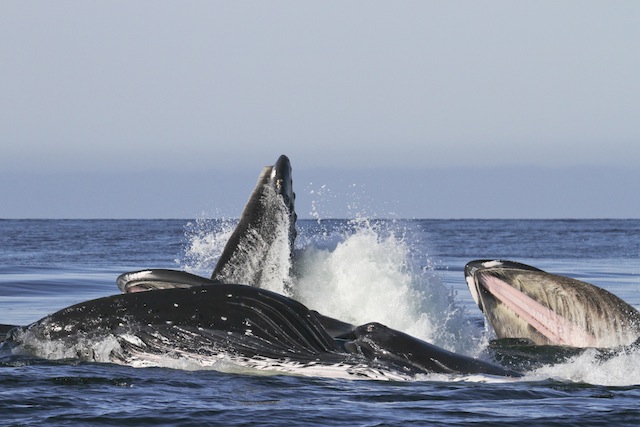
Caamano Calling
I’m sending this report from Cetacea Lab, a whale research station halfway up the BC coast. Back on land, I remain soaked in watery sound, immersed via stereo feed to a network of hydrophones drilled to the ocean floor. I’m listening to Caamano Sound 30 meters down: its aqueous stratum of warbles, bleeps and burblings. Most of my time is spent in the lab, looking through the window and listening. Jilann, a whale watch guide from Vancouver, enters data on the computer. Philipp, an engineering student from Switzerland, crouches on the floor, assembling his camera. Every summer, when pods of whales travel to BC’s coast from as far as Oahu, Cetacea Lab gathers interns from around the world to assist its activities.
My research encounters geography through the medium of sound, which I consider to be a uniquely expressive source for understanding the ways we shape the world and are shaped by it. For me, Caamano Sound functions like a gigantic resonator -- an area, like the inside of a guitar, detecting and intensifying frequencies. Resonators are not just ways of thinking about acoustics, but places, and the way they consolidate different frequencies of practice, positioning, and political economy. Powerful Gitga’at namings are inscribed into the lands around me -- conduits to worlds I cannot access. They are tied to the raven, eagle, orca, and wolf calls that also make this home. I’ve read stories of Spanish frigates sounding through these waters in the eighteenth century, and a BC Ferries vessel crashing to the seabed in 2006. One day there might be Passive Acoustic Monitoring stations as well -- remote sensors to guide supertankers around whales and shorelines and toward the open ocean.
I first heard of Cetacea Lab because of the Northern Gateway Pipeline: the tar sands delivery system that would transform Caamano Sound into a marine superhighway. Since the project’ proposal in 2005, life at Hermann Meuter and Janie Wray’s outfit has changed dramatically. Once a quiet endeavor, Cetacea Lab has become an outspoken part of the local resistance. Actions with NGOs have been worked into its travel schedules. Exchanges with Hartley Bay, the nearby Gitga’at village, transpire daily. Through it all, Caamano Sound’s fragile whale habitat -- harmed by increased boat noise, shattered by an oil spill of any magnitude -- has been raised to great political heights. My hypothesis is that our instrumental relationships with these creatures - how their voices feature in the voicing of our politics - is key to making sense of Caamano Sound.
Whale Time
Days go from 6am to 9pm, with visual scans every 15 minutes and data entry every 2 hrs, but so far as I’ve experienced it, whale science runs fundamentally on Whale Time. Whale Time means long periods of listening to nothing but empty signal. It also means kicking one’s way out of a tent at midnight to run to the lab and hit ‘record’. Humpback song can last for hours, and all the recordings and photos we’ve collected give Cetacea Lab months of material to sift through. Spreadsheet entry can make for long shifts, but there’s always the chance Hermann comes bursting through the door -- “Whales! Whales!” -- to send us all onto the balcony with binoculars and cameras. Moments just flow in these animal-encounters, counterpoints to the tight techno-rhythms of Human Time. Half-awake one brutally early morning, I heard Hermann’s big feet racing toward the lab before stopping outside my tent. “Wolves, Max! Wolves!”
Cetaceans of a New Age
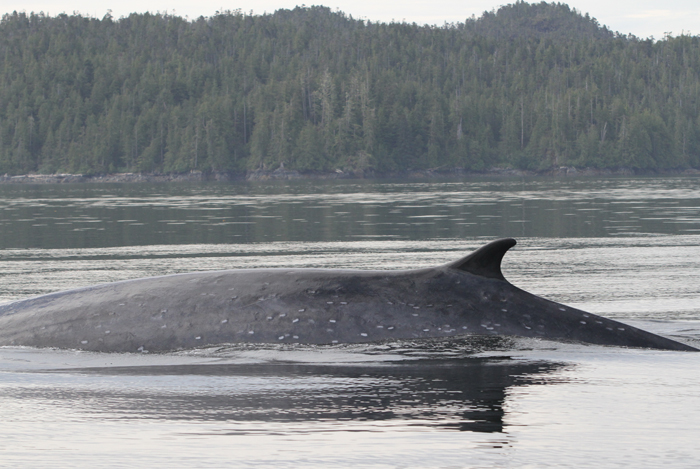
Among the things I packed on this trip is a musical instrument called the Sensula. Its a variation on the Kalimba, the African thumb piano recently popularized by the likes of Grimes. My Sensula is tuned to a dreamy A-Minor Pentatonic, producing glassy shimmers and cross-fades when struck. There’s a fascinating history of humans attempting to communicate with whales via jazz flutes and guitars; elaborate hookups aboard floating barges. My plan to teach myself the Sensula was a bit of a self-joke, but playing it has provided field-notes for understanding the ethos that characterized those hopeful endeavors. New Age easily tends toward the shallow and self-indulgent, but I think its guiding message rings true - we are in a New Age. Big changes lie on Caamano Sound’s horizon: an LNG project will see more ships charting through in the coming years; counts of orca and humpback continue to project upwards -- with fin whales now among their number. Hartley Bay is planning a host of economic initiatives, but they all depend on stopping a pipeline backed by Prime Minister with a fondness for cruelty. Cetacea Lab is a good place to begin listening in. The dedication here is inspiring.
Wolves meet Whales
It is just before midnight, the sky is alive with stars and the horizon still hints at the spectacular sunset that left us hours ago. In the bay a lone humpback can be heard, blow after blow as he travels back and for forth, perhaps looking for a companion to share this evening with. What follows next may not have been the kinship this whale was expecting. A pack of wolves, spread out from one end of Taylor Bight to the other began to howl. We stand on the deck, listening to wolves followed by a blow that echoes through the surrounding forest and wonder if they may be a dream.
Have a listen for yourself below. We wish you could have been here to share this moment in time when wolves meet whales in an acoustic melody only nature can create.
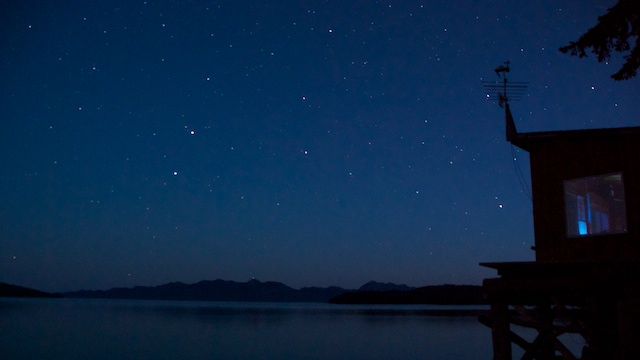
Blood Red Tide and Whales
I awoke at 5:00am hoping to get an early start with the day’s whale survey. At first glance I was instantly worried, the fog was so thick I could not even see the other side of Taylor Bight. We decided to just get ready and hope for the best. By the time the boat was packed the visibility had not improved one bit; we would just have to travel extremely slow. Just as we headed out I was looked away for just a moment to get my thermos of coffee out of the bag (I had not yet had my morning java, a necessary ritual). Well that was all it took. I thought I could follow the compass in my heart to find our way but was I ever wrong. I was watching the shore and thinking something is really wrong here. When the lab suddenly came into view I was stunned!
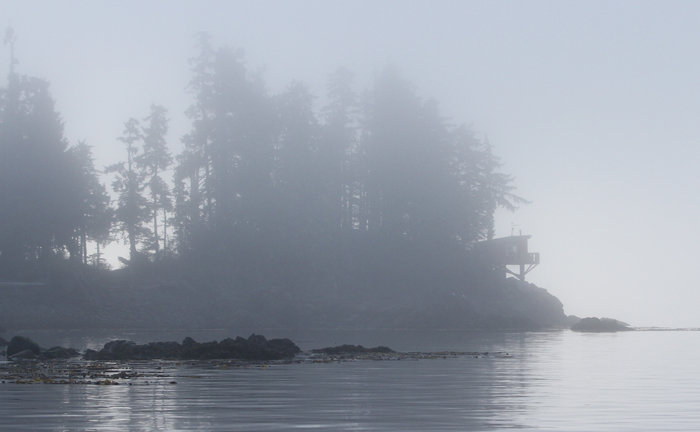
I was suppose to be traveling west and had accidently gone east!! That is how thick the fog was. I knew that for the rest of the trip I would be relying on the boat compass and any sign of the sun for direction; my gut was fired. We traveled for about 20 minutes then shut the boat off. There was no way we would be able to find whales in this thick, moist fog, instead we would rely on the exact same sense whales depend on – sound. So there we sat, the boat floating silently in the mist on a glassy calm sea. Not a single word between the 3 of us was spoken. The intense focus for us all was the same, listening for the sound of a blow. Within 5 minutes there it was, so faint we could just make out the direction. I turned on the boat and inched forward as the fog wrapped itself around us. We traveled slow for 5 minutes then stopped again, listening to hear if we were any closer. Within moments we could hear not one but 2 blows; we were on the right path. We repeated this method over and over, each time that much closer to the sound of blows. I personally love this method of trying to find whales. To depend only on the sound that surrounds us, unable to see, immersed so deep into the moment you involuntarily become completely unaware of any internal chatter, only the stillness - and then a blow.
The closer we traveled towards the whales the more the fog was burning off from the morning sun; this was going to be a hot day. The mist gradually parted way and finally we could see and there they were, 2 resting giants slowly traveling, side by side, in this soupy calm sea. We approached with caution as not to disturb them. It was then that we noticed they were traveling through a massive bloom of red tide. The motion from the whales gave the eerie perspective that that ocean was bleeding which naturally brought all of my thoughts to that of this absurd proposal of oil tankers bringing death to these waters.
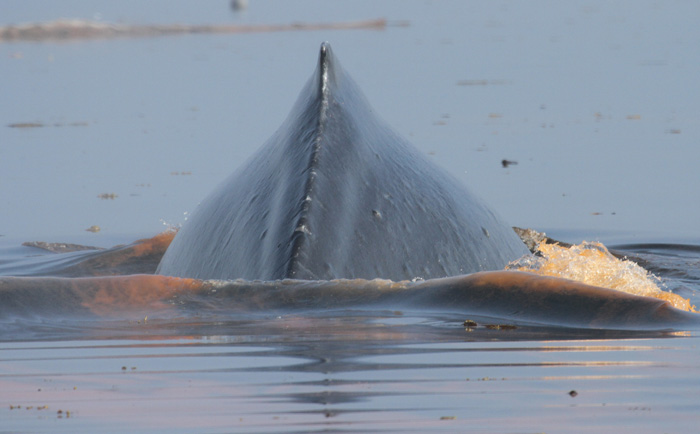
After a few more minutes each whale took in a huge breath, this is always a signal they are about to dive and the opportunity to see the underside of each fluke was hopefully just moments away. The larger of the 2 whales fluked first and we were not surprised to see this was a female who last year had brought her first calf to these waters. I was so curious to see who her companion would be. Slowly the next whale arched its back, then one by one each vertebrae would bend forcing the tail up towards the sky. I was thrilled to recognize this whale immediately as another resident known as Specs.

By now the fog had completely lifted, revealing a perfectly sunny day with waters so calm the surrounding emerald green rainforest was able to reflect her to beauty to the sea. Time was getting away from us and we had to make our way quickly to Hartley Bay. Both Julie and James would be leaving today, 2 interns that had filled our days with laughter and inspiration. I knew it was going to be sad to say good bye to both. We would share one last whale encounter before arriving in the village. James had spotted a distant blow along the Gil Island shore. While traveling towards the location we saw a blow I thought I spotted a log floating on the surface. This was no normal log though, as it suddenly came to life with a soft exhale. Yes, this was a sleeping humpback whale. We shut down and sat in awe as this beautiful creature of the sea laid beside us, resting, breathing every couple of minutes, oblivious to the world above water. It is when whales are in this vulnerable position I worry about them most in regards to being struck by a marine vessel. Even as I had traveled towards this sleeping whale it had not budged. I wonder if these creatures live so many days without the emotion of fear, even after decades of hunting they still trust us. Oh to be a whale and forgive so readily. We could learn so many lessons from these intelligent and passive beings of the sea.
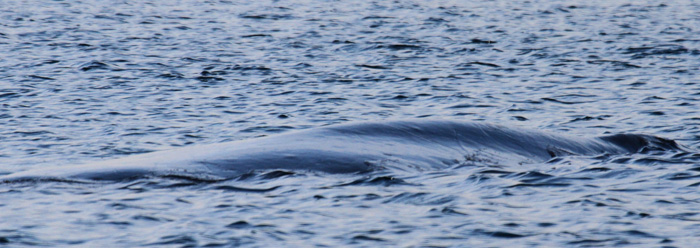
One hour later we are at the dock in Hartley Bay, hugging and saying good-bye. At the same time 2 new interns are arriving. As the ferry pulls away one last wave as Julie and James begin another journey back to their lives to other parts of the world. We pull away from the dock, another day, another experience to be shared here, where the sea ripples her beauty alongside the Great Bear Rainforest.
3 Months on Gil Island in a Wet Tent!!
Wriiten By Aaron Kirkpatrick
After 3 amazing months it is now my last night on Gil Island. The last month has passed by in a whirlwind of whale activity and nice weather, yes I said it nice weather! Two weeks spent on Ulric Point again and two my last two weeks spent at the lab. It has been a magical month and I will try my best to summarize all the whale activity. It all started when I headed back to Ulric Point for another two weeks on the out camp, the second day we were there we had started to hear orca calls on the hydrophone and we had a report of orca on the southern side of Campania. At the time we had the Roller Bay visiting so they took off straight away and I called the Guardian watchmen who headed out in their boat and took me with them. We soon found the orca between the Wall islets and Dupont Island; it was the R4’s and the B’s. It was amazing to see these beautiful animals again, the sun was beginning to set and as their blows came into the air they would sparkle in the sunlight. We followed them for what seemed like hours and even had them swim right underneath us, there really is nothing else as magical as an orca swimming right under the boat and you can see all of their markings. With seeing the Orca I was quite content to spend the rest of the two weeks not seeing whales and I would have been happy.
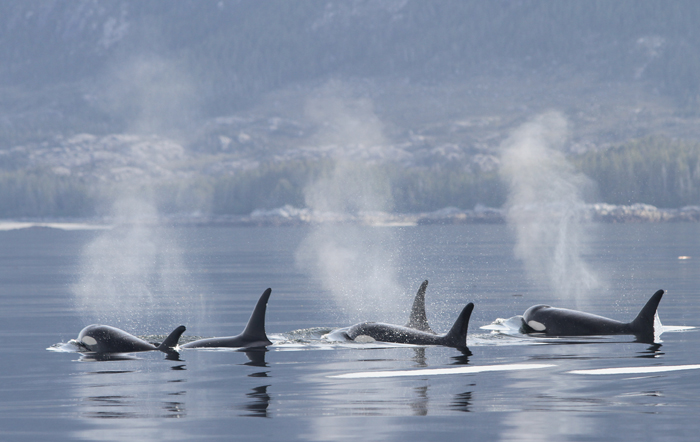
A few days later however we were lucky enough to have 13 humpback whales come by the shelter and bubble net feed right in front of us multiple times, they were just beyond the kelp line which was just amazing to see. It was really special to be able to listen to the whales making their feeding calls and then see them erupt through the water with their mouths wide open. Again I was left speechless and would have felt content if I didn’t see another whale for the rest of my time on Ulric. Yet again though only a few days later the hydrophone was ringing with the sound of Orca, we eagerly waited for them to come out of Beauchemin Channel and then it just got plain right crazy. There were orcas everywhere across from us to Rennison. We had orca in the distance, orca mid channel and even orca right in the kelp in front of us. The whales slowly all headed north and we thought everything was over when all of a sudden a female and tiny calf came right around the corner. The calf was so small it was just so tiny. Then we heard echolocation as the mother disappeared into the kelp. The calf then started darting around the water and I was holding the camera when its whole head came right out of the water. Yet again another story to add to the long list that has grown constantly here that I will never forget.
To top it off the very next day we had another mom and calf, this time of the humpback variety. The mom and calf seemed to be sleeping and slowly passed us when the calf suddenly headed straight into the kelp and started rolling around. They then slowly took off and we were left alone just smiling to each other at what we had just seen. As we were writing everything down they came back and this time we headed out onto the rocks to get a closer view. The calf started rolling in the kelp only about 10 meters from me and then one of the single most amazing experiences I have had occurred.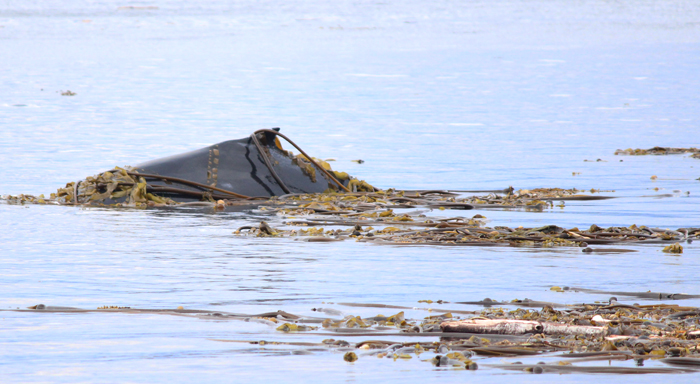
The calf came right towards the rock where I was stood it couldn’t have been more than 7 meters away from me when it stopped and its head slowly rose from the water. I just looked at Rachel in complete silence and we both knew something special had just happened. The calf took off and then out of nowhere started breaching; it was amazing to watch this tiny calf breach out of the water multiple times. We ran across the rocks and followed them and watched as the tiny calf just kept breaching and breaching. What an unreal few days, surely I thought it couldn’t get any better? On our final night however I was very fortunate to head out with the Guardian Watchmen when orca started to show up, they must have been lined up across Aristazabal for 2 miles and we slowly made our way across them getting ID shots. It turned out we had the A24’s, A4’s, I31’s and the I11’s. It was just amazing to get to spend more time on the water with these beautiful creatures. We followed them for hours and eventually ended up off shore on the west side of Rennison when I spotted some splashing in the distance which I thought was an orca so we headed out further, and boy was it worth it. A small juvenile orca breached 3 times right in front of us. It really couldn’t have been more perfect, the snow capped mountains in the background, the silent still water, and this little juvenile orca jumping out of the water. I was extremely lucky to get an amazing picture of this and it is definitely something I will treasure for a long time. What a two weeks on Ulric Point, what an amazing and special place which I will definitely miss.
The next day I was back on Gil Island struggling to put up my fantastically unreliable tent. Fortunately the weather really had changed since my first few weeks here and it was bone dry and warm. It’s quite nice to sleep in a dry tent, something I have not experienced much since being here. A few days after being back I was on shift when I was standing on the balcony watching a mother and calf humpback about a mile away from us. All of a sudden the calf breached and it was just amazing to see the whole body slowly turn in mid air before smashing into the water and creating a huge wall of water on all sides. Over the next few days the weather was still amazing and I was standing on the balcony early in the morning with Hermann, the water was just crystal clear and we joked that it would be unbelievable if a humpback came by that morning because we would see the whole body underwater. Well I think some whales had been listening to us because slowly around Fawcett point came two very relaxed humpback whales. They slowly drifted around Taylor Bight and then right in front of the lab. They really couldn’t have been closer to shore unless they beached themselves. What a sight, two humpback whales both completely visible under water. Just stunning and simply unbelievable we watched them slowly drift by us and you could see their huge pectoral fins just gliding through the water. What an image, it will certainly be burnt in my memory forever. Two days later we had more humpback fun, a lone humpback in the distance breaching constantly over and over, then he would roll onto his back and just slap his pec fins down, the air was silent until he would bring one of his huge pecs down on the water and it would sound like a gunshot going off.
This all passed the days quickly as you can imagine and soon enough it was my last week on Gil Island. It was also Rachel’s last week and so we decided to take a day of and go over to Campania Island and climb X Mountain. What a hike! It was a long way up by it was worth it, and we even spotted some whales on the way up. When we got to the top you really got an amazing view of the surrounding area and it really made you feel how unique this area really is. I couldn’t even imagine an oil tanker 3 football fields long travelling through such a peaceful spot. After we thought Rachel would be leaving the next day but I guess fate had one last twist for her Gil Island adventure, the ferry had broken down so she had to stay an extra day. She could not have had a better experience. I woke to her shouting Orca and ran out to the lab to see two groups of orca slowly drifting by Ashdown, instantly Hermann was in the boat with Rachel heading towards the orca. When they reached them I just saw orca everywhere at least 20! They were resting and were probably averaging about 0.0001 knots. Hermann and Rachel then headed back and Claire and myself were able to see the whales. They had barely moved 30 meters and we soon caught up. It was just incredible the water was almost completely flat, there was a huge group of resting orca and the fog had just started to drift over the trees. What an image! We watched as they slowly drifted up and down and then finally woke up. Hermann had the camera and just as he was holding it up one of the orca sky hopped. WOW!! Something that I had not yet seen but will probably never forget, this whale came out of the water without making a single sound and raised the top half of his body out of the water, the sun was shining right on his white belly and he was just bright white. What an amazing sight!
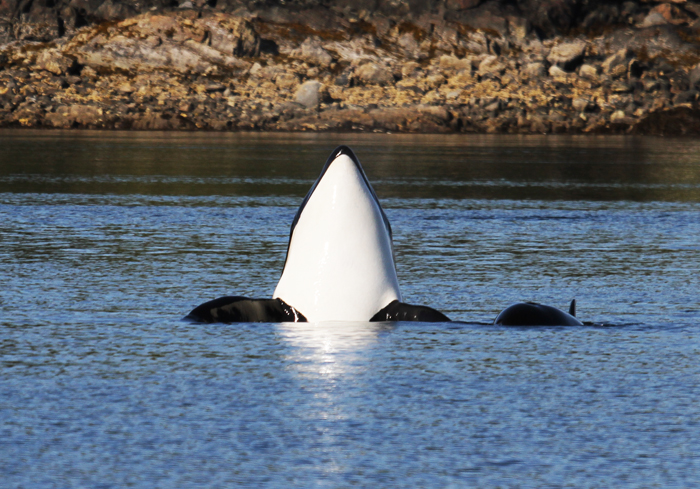
After the whales turned around and headed straight into Taylor Bight and started foraging, they were spread out everywhere. We drifted into the bay and just watched in awe as the orca went about their everyday lives. What an unforgettable orca experience and one which will probably be my last at Cetacealab.
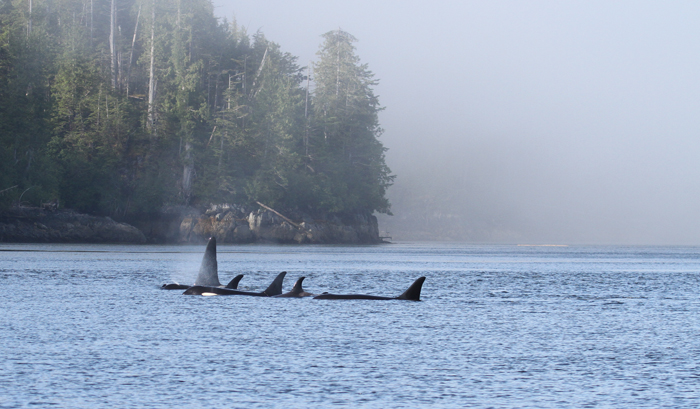
It has been an amazing 3 months and words really can’t describe the experiences I have had. The whales, the scenery, the Gitga’at people, Hermann and Janie have all been just unbelievable and I will certainly not forget this place. Anyone who would even spend half a day in the Great Bear Rainforest would soon realize what a special place it is and I feel truly grateful that I have been lucky enough to experience everything it has to offer. It is hard to describe this place, it is such a healthy and peaceful environment, it has so much to offer to us and it would be a sad day if an oil tanker route were accepted, as we would lose everything here. I will miss just about everything on Gil Island (apart from my tent) and will no doubt find myself back here at some point in my life!
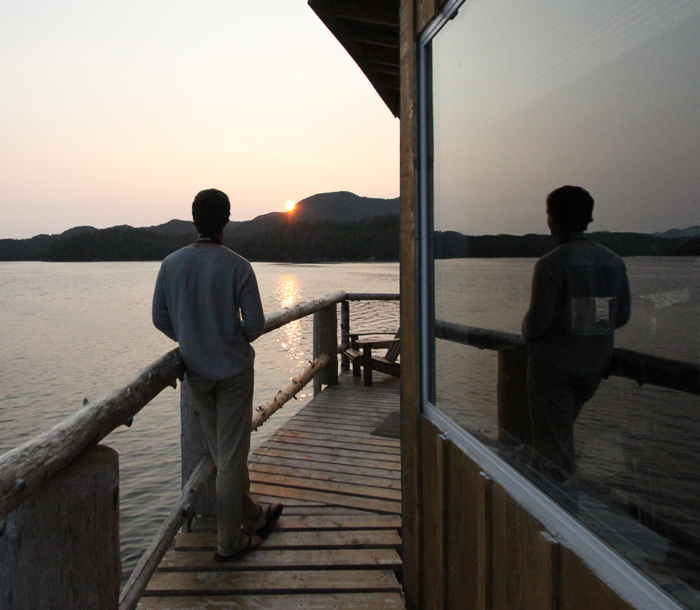
Saying Good Bye to Cetacea Lab
This Blog entry was written by Megan, one of our Interns just days after she left to fly back to the UK. We felt it should be shared and read by all as it speaks from the heart as to how truly special this entire and area and the people who are trying to protect it are.
Leaving Cetacea Lab
Prior to my arrival at Cetacealab I had many thoughts and feelings about what my time on Gil Island would be like. It was a mixture of anticipation and excitement, but mostly it was the butterfly feeling you get in your stomach of the unknown. I knew I would see whales, and most of my thoughts for the last 19 years of life had been centred on them, so for that reason alone I knew this was a dream come true. But the feelings that I have left with are far different from what I even imagined. The people that I have met, the things I have seen and done and the switches that have flicked in my mind since I first set foot in the Great Bear Rainforest have been far beyond what I ever initially imagined.
The fear of leaving this place only actually occurred to me the evening before I left. Sitting in the wooden armchair by the bath with Amber purring in my arms, whilst quietly sobbing in to a lemon tea, watching the sky turn pink and listening to the prehistoric sounds of the ravens sitting above in the magnificent cedar; I knew then the next morning was going to be an emotional challenge.
On my last morning I awoke in the lab about 5am and decided not to waist a single second. I grabbed my waterproofs and the life vest and took to the Canoe. It was lightly raining and the water was so glassy calm that each drop could be seen bouncing off the surface. The only sound was the water dripping off the ore as I made my way round the Bight. That was until I awoke a sleepy humpback whale 200 meters ahead of me. He took one gigantic breath and then dove. Wow, just when I thought last nights visit from two humpbacks at sunset was my final whale encounter. It just goes to show how unforeseen my experiences of this place have been. Sole, by this time was on the deck with camera in hand for the whale’s next move. I lightly tapped the ore on the side of the canoe a few times to let him know where I was and after 5 minuets the whale surfaced across the other side of the bight. I watched him leave pass York Point and by this time I was soaked by the rain. After 3 hot cups of coffee and the last minuet stuffing of sleeping bags and thermals into my oversized backpack it was time to load the boat and say our goodbyes.
Standing at the back of Elemiah with Neekas trapped between my legs’s waving goodbye to Janie, Katie and Kirsty on the lab deck with tears streaming down my face is the last memory I have of Whale Point (2012). After another emotional goodbye to Herman and Neekas, a peaceful wander around Hartley Bay and an amazing seaplane adventure over The Great Bear Rainforest with Jen and Sole we all made our way back to Vancouver.
After such an incredibly life changing 6 weeks the only words I really have left is thank you, thank you, thank you!
So thank you to the Gitga’at for keeping this incredible land so pristine and intact, your humble beliefs have left me speechless. Thank you to every single person and creature that has passed my way over the past 6 weeks at Cetacea Lab. Thank-you for the what you have taught me, for the things you have said that have moved me, and the thoughts you have given me to take on my way back around the world.
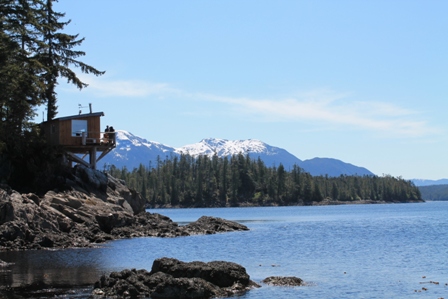
But most of all Thank-you to Janie & Herman. Thank-you for their incredible hospitality, for their amazing humour and whit, for their strength for when things don’t go according to plan (which often happens whilst 40 feet up a tree with the wrong screwdriver) & thank-you most importantly from the bottom of my heart for the work that they are doing to ensure that the whales that inhabit this pristine and irreplaceable part of the world will be better understood and forever protected in these waters. The task at hand is one of such great importance and I have the sincerest optimism that every person that sets foot on Gil Island will forever be changed, Mind, Body and Soul, just as I have.
Every Must Read this by Alexandra Morton
Written By Alexandra Morton
A major TV news station aired an investigative piece a couple of nights ago on their evening news show, about Kudoa infested farm salmon fillets for sale at COSTCOs. The reporter goes undercover to interview a COSTCO employee:
Kudoa is a flesh borne farm salmon parasite that liquifies the flesh of the fish after it is killed. DFO has tried to help the industry figure out how to prevent it: but Kudoa caused $4 million dollars (NOK 23 million) in losses for Marine Harvest in BC last year
Many people are asking if it is healthy to eat Kudoa. A different species of Kudoa was related to food poisoning in Japan. I am unclear if tests have been done on the species that has become epidemic in BC farm salmon. Best to write to
This e-mail address is being protected from spambots. You need JavaScript enabled to view it
.
In another development, while the governments of Canada and BC refuse to acknowledge that BC Atlantic farm salmon are testing positive for highly contagious and lethal European salmon viruses this note on their website was brought to my attention.
"Under some circumstances, under the Health of Animals Act, the Canadian Food Inspection Agency may need to treat wild fish populations to control fish pathogens that may have been introduced into Canadian waters." (see Q4)
There is no treatment for these European viruses and unless they are referring to other "introduced" pathogens I have not found yet, I can only imagine they are considering culling wild salmon that test positive for European viruses to protect the farm salmon. If you want to investigate this please write to:
This e-mail address is being protected from spambots. You need JavaScript enabled to view it
Feel free to cc me.
I hope you will consider joining over 11,000 people in asking supermarkets to stop selling diseased farm salmon. I don't see any other way to deal with this issue. Every other region in the world that encounters these viruses has taken action - except BC - which is the only salmon farmed region in the world with an extremely valuable wild Pacific salmon fishery at risk. Our governments are immobilized caught between aggressive lobbyists and trade laws.
SIGN PETITION HERE
CONTRIBUTE TO OUR LAB BILLS
I am working on a solution to government's abandonment of BC wild salmon - more later.
Hope you are getting some time to relax and enjoy summer. Thank you for your involvement in protecting wild salmon.
Alexandra Morton
alexandramorton.typepad.com
Roy Henry Vickers and Transient Orca
Last week we had an amazing visit at Cetacea Lab by a man we have admired for years - Roy Henry Vickers. Not only is he one of the most inspirational artists of our time, his deep spirituality and connection to the earth had a deep impact on us all. During this visit he held us captive with the calmness of his voice and stories. Then he shared the gift of song as he sang from the balcony of the lab. We looked towards the sea, some with eyes closed, as the vibration of his voice touched something unique and special in each of us. In the days that followed a few of the interns traveled with Hermann on a whale survey. To follow is the experience of that day and the magic that Roy left with us all.
Written by Rachel Speer
The day started with two but beautiful humpback whale encounters on our path northbound to Hartley Bay. We took a bit of a break in the peaceful village of Hartley Bay so Hermann could runs some errands and check the mail. Soon we were back on the boat heading back south down the other side of Gil Island. We had not seen a whale in quite some time so Hermann began to sing Journey’s “Don’t Stop Believing” and so it became the humpback whale song. I happen to have the song on my phone and so played it while singing along on the bow of the Elemiah, searching for whales. It only took twenty minutes and we encountered two more humpback whales who came together to lunge feed followed by two more; a great continuation of the day.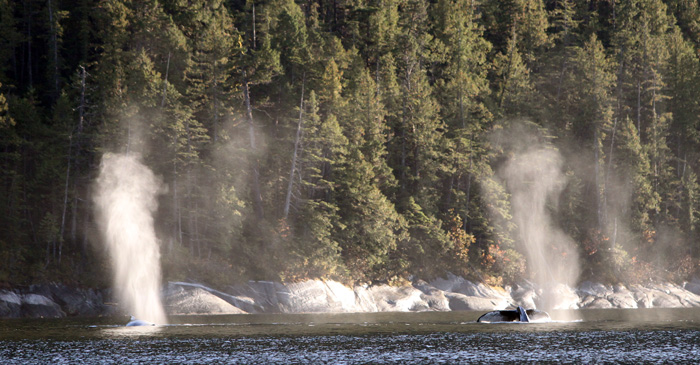
A little while later we spotted a huge fin whale that came into view. At the same time we heard some scratchy talk about orcas on the radio. A quick ID shot of the fin whale and we were off!
We headed in the direction of the suspected orca sighting but no one seemed to know where they went or even if they were 100% sure they were orca. We were bobbing in the boat not really going anywhere when Sole mentioned that we now needed an orca song.
Just five days earlier, the British Columbian artist and inspirational figure, Roy Henry Vickers, came to visit Cetacea Lab. While Roy was there he gave us a great gift. We all gathered on the deck of Cetacea Lab and he sang us a travelling song from the house of Walkus . This song’s key message when translated into English is, “We will go all over the world pulling together. We were born to do this, it is true.”We will go all over the world singing together. We were born to do this, it is true. All of us who experienced the song were deeply moved and filled with such emotion it brought tears to our eyes.
I instantly knew that I had to play Roy’s travelling song. The last time Roy had been in the area he experienced a magnificent event; a super pod of over 75 orcas. So it was not surprising that just one minute after I started to play the song the wheels started turning, and other boats put together information that led us to where the orcas had gone. We identified them as a transient group of three females and two juveniles, although one of the females was travelling far off from the others. These orcas take several breaths before diving under for about 15 minutes. The time they are visible can be short and they can pop up anywhere after a long dive. That’s just what they did. We were scanning the horizon when the smaller juvenile popped up ten feet off the back of the boat followed by the others nearby. We continued along with them for about a half hour south as they went back under for lengthly periods of time when Hermann said, “One more up and we’ll head back around.” Interestingly enough the next time they came up they were making circles and heading north again so we turned around with them and slowly kept on. Then when they got a bit ahead of us the juvenile breached twice in the distance and then they disappeared again under the water.
We continued to slowly head north waiting for the next sighting when they showed up right around the boat, all three all at once circling within 20 feet checking us out. I couldn’t believe they had taken such an interest in our presence. Even Hermann was in awe having never had transient orcas come that close and hang around like this before. A second later the juvenile came up ten feet away heading straight in our direction. All three of us couldn’t believe it when he kept coming and swam right to the boat coming up again maybe two feet from the motor before diving under the boat. We all ran to the other side and caught sight of his white markings as he swam under the water before coming up so close to the boat Sole and I could have reached out and touched him; we were frozen in amazement. This was very unique behavior to begin with, but more expected of a juvenile due to their playful nature and curiosity so we were really shocked when one of the full grown, adult females came to check us out a few feet from the motor. She was swimming under water and you could see the width of her whole body as she passed by. You can’t really imagine the immensity of these creatures until you are right up next to them like this; it was just incredible.
We were drifting south in the current and away from the orca who kept milling around and then disappeared under for a while again. We turned the boat back on and headed back up to where we last saw them and waited idling in the about the same spot. They showed up a few minutes later and Hermann shut the engine off. At the very moment Hermann turned the key the juvenile made a B-line for the boat. He took a breath maybe thirty feet from the boat and went under. We were scanning the water to see where he would turn up when all of a sudden maybe ten feet under the water we spotted him swimming belly up right underneath the boat. I nearly tipped over the side of the boat trying to keep him in view completely mesmerized. You could see all of the white markings on his belly and the huge expanse of his pectoral fins gliding through the water. Again we ran to the other side of the boat where he came up and took a few more breaths nearby before heading out to meet back up with the rest of the pod who were continuing south. It was like he was giving us a farewell before leaving us.
We thanked the orca for this incredible experience as they picked up speed and headed off. Even now as I sit here writing about that experience I am filled with emotion and an image that will be seared into my mind forever. We watched them go for a while before turning into the sunset and heading back north to Cetacea Lab. The ride home was pretty quiet as we all relished in the emotion and empowering experiences of the day. Every now and again Sole and I would glance at each other from across the boat and just laugh in mutual understanding, knowing that we had just had the experience of a lifetime. I will forever remember this day and treasure every moment.
Orca Researcher to Eagles to Intertidal Explorer in 7 Days
Written By; Sole from Spain
This blog post is a story on how someone can go from being a marine scientist and potential orca researcher, to a bald eagle photographer and extreme intertidal explorer in 7 days.
First of all, let me explain what “Ulric Point” is, where it is, and the purpose of this station.
Ulric point is a spot on the Northern end of Aristazabal Island, 16 miles South from Whale Point. Nobody lives there apart from the bears, wolves, minks, bald eagles, and other wildlife. At this remote spot there is a little shelter made of ply wood that overlooks the waters of Caamano Sound. Our little shelter is small and beautiful, but I would not say it is comfortable; sometimes it leaks when it rains. We can hang our cooking utensils from the nails on the wall, the propane stove fits just fine, and the rest of the furniture consist of a VHF radio, 2 batteries, solar panel, a small laptop, the SLR camera and the ‘Big Eyes’ (very powerful, bulky and heavy binoculars).
All of these elements are our working tools. With them we arrived in Ulric on a beautiful, sunny Saturday afternoon, the 2nd of June, ready to document all resident and transient orca activity. For the next days we anticipated spending hours observing their behavior, taking photo ID’s, and listen to their vocalizations. WHAT A GREAT PLAN!!!!
So, as I was saying, we got there the second day of June: Hermann, Aaron, Neekas (the wolf-dog) and myself (Sole). Hermann and Neekas stayed overnight to help us set everything up. We put up our tents, connected the batteries to the solar panel, got the VHF radio ready so we could be in touch with the rest of the world.
On my second day at Ulric I learned how to build a toilet in the rain forest. I will explain the whole process because I find this information very useful and truly believe it could save your life one day:
List of material and working tools: some lumber, a shovel, a saw, an electric –wireless- screwdriver, screws (lots of them) and a toilet seat…oh! And bug spray.
- You dig a deep hole (the depth depends on how much organic material you are planning on deploying there).
- Cut your pieces of lumber to make a structure right on top of the hole you just dug. It has to be about half a meter above the ground level if you don’t want to end up doing sit ups every time you go to the toilet.
- Place one flat piece of ply wood on top of your structure. MAKE SURE IT HAS A HOLE THE SIZE OF A TOILET SEAT!!! Otherwise, the instructions on this manual would end up being useless.
- Put the toilet seat on top of the hole, and screw it onto the ply wood.
VOI LA!!! Your rainforest toilet is served.
Remember: has to be far enough from your tents, but not too far for emergencies, if you know what I mean.
So the station was ready for the season of 2012. Hermann and Neekas were off, back to Gil Island leaving Aaron and I facing wilderness all alone. CHALLENGE ACCEPTED!!!!
June 4th. 7:30am. Binoculars ready, 3 layers of clothes on, and…
“ORCAAAAAAAAAAAAAAAAAAAAS!!!!!!! ORCAAAAAAAAAAAS!!!!”

There they were, 2 nautical miles to the west. One group of 6 whales with two huge males; another group with a mother and calf with two loners further ahead. Imagine our excitement. Our first minutes as killer whale researchers on our own island and we already had lots of swimming mammals around. What other great adventures would be waiting for us around the corner for the next 6 days!?! Probably hundreds of orcas breaching in front of our shelter every day! Sea lions swimming away from the great hunters of the ocean! And much more!!!! All these thoughts filled our minds at that moment, 7:45am on the 4th of June.
Time would soon prove us wrong. Oh so wrong.
For the next days we were working on a 3 hours shift rotations, starting at 6am until 10pm, going to bed with the sunset. While one of us would be at the shelter scanning for whales, the other was free to explore the island.

- To the East: a very long rocky beach, with a beautiful small creek half hour away from our tents. The creek was great for taking a bath, always keeping an eye for curious visitors such as bears or wolves.
- To the West: steep rocks only suitable for very experienced intertidal explorers as ourselves;
- To the South: deep, thick rainforest
- To the North: the ocean. No exploring here. We did not have enough rope to build a raft with all the logs along the shore.
We mastered the slippery-rock climbing; became experts on tide timings for finding intertidal species (sea stars, anemones, mussels, baby rock-fish, limpets, barnacles, etc); took long beach walks holding the bear spray on one hand and the handheld radio on the other; spent a couple of hours setting up a rain water collection device (it didn’t rain for 7 days); did a little excursion into the thick rainforest and found one wolf footprint; made friends with our neighbors the little mink, the bald eagle and his grumpy landlord (maybe “treelord” would be more appropriate) the raven;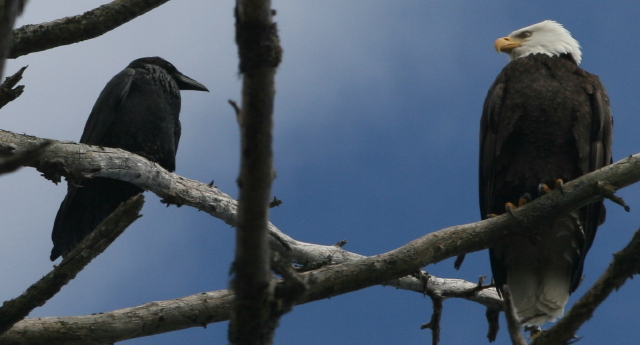
put up a tarp to protect our fabulous toilet from the rain (wish it had worked for bugs too); learned to collect sea water directly from our shelter using a bucket and rope so we did not have to climb through the rocks every time; watched four humpback whales feeding 6 or 7 miles* from us (*distance translation: we could only see the blows with the big eyes and under excellent visibility conditions); we tried fishing for salmon from the rocks using a rope and macarroni&cheese leftovers as bait. One evening, two humpbacks visited us for a brief moment 50 meters from the shelter ; and…
…”What about the orcas?” You may be wondering. Well, NOTHING about them, literally. Nada, niente, rien de rien, zero… I do not know where they were, but one thing I am sure of is that they were NOT around Ulric Point.
So we spent half of our 3 hours shifts desperately looking for any sign of these great mammals, and the other half taking photos of our friend the Bald Eagle. I have to confess that we are better rock climbers than photographers, but we keep trying.
And this is how you can go from being a marine scientist and potential orca researcher, to a bald eagle photographer and intertidal extreme explorer in 7 days.
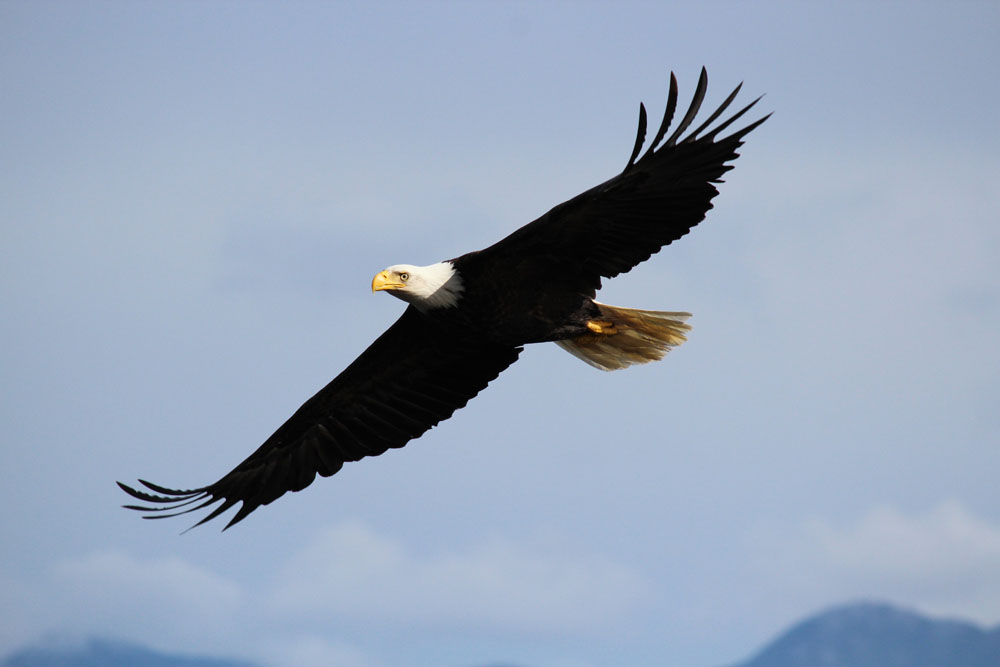
Now I am back in Gil Island. Megan and Aaron are in Ulric looking at the horizon hoping to find those orcas. Wish them luck.
I must say I loved the experience and would go back there at any time, with or without orcas.
Whales and Oil Tankers
It is 5am and the day is starting early with humpback feeding calls echoing through the lab from the Squally Channel hydrophone station. The length of each call session suggests this may be a large group of humpback whales bubble met feeding together. We quickly pack up the boat with our recording gear and cameras and head out on the water. It is still early in the season for such humpback activity, but in so many ways this year has been so unpredictable anything is possible. After a 30 minute boat ride we could see at least 5 of heart shaped blows in the distance. I slowed the boat down as I was not sure which direction the whales were traveling in. This turned out to be a grand decision. We had just positioned ourselves, with the boat turned off, when we could hear feeding calls vibrate right through the hull of the boat; they had to be very close! Sure enough moments later the water began to bubble 100 meters from the boat, herring were jumping for their lives followed by an explosion of massive humpback mouths gaped wide open filling with fresh fish.
A number of tonal blows, grunts and squeals filled the air as one by one each whale re-positioned themselves in a circle and began a new sequence of coordinated dives. With the last whale to dive I tossed the hydrophone into the water and began to record their haunting and extremely effective feeding calls. The whales below began their spiral dance, blowing bubbles in a circular motion, forming a net that would force a school of herring to the surface. The feeding calls would further frighten the fish into an even tighter ball making the feeding frenzy that would occur on the surface that much more successful.
This event repeated itself for hours. We were able to take a photograph of each dive sequence as well fabulous identification pictures of each whale. Another whale joined this group and I screamed with delight when I realized who this whale was. Her name is Velvet as her fluke is completely black. She was one of the last humpback whales I had seen in October last year before the migration south. That late fall day in 2011 was also the day I realized that Velvet was a female as she brought her young, healthy calf right to side of the boat. Now she is back, this time without a calf, but she may well be pregnant again. If so, she will need every bit of nutrition these waters may supply to regenerate her fat cells and storage of energy. We were captivated for over 6 hours with this group of humpback whales but the weather was changing and I knew Hermann would need the boat to check out one of the hydrophone stations later today.
Once we were settled back in the lab I checked my email. Colleges’ of ours had sent an email with a picture that I just cannot get out of my mind; one that haunts me now as I write this blog. They had taken the time to produce to scale what a VLCC oil tanker would look like traveling through Squally Channel, part of the proposed tanker route for the Enbridge Project. This is the exact location we had just spent hours watching these magestic whales feed nonstop for hours. It is shocking to say the least that anyone could even consider this route for such a massive tanker. They are as long as 3 ½ football field (350 meters) and could carry up to 2 million barrels of crude oil; the destruction from a spill of this magnitude would leave this pristine, diverse habitat completely lifeless. The slightest mistake would lead to a catastrophic event destroying one the last intact ecosystems with in British Columbia.
We hope that you will stand with us and agree that oil tankers do not belong in this marine masterpiece. Now we say good night as another day in this remote place of pure wonder becomes night. With any luck we will be listening to blows in the bay beneath this star filled sky.

Oh Those Fin Whales are Massive!!
Written by Jenn Dickie
It is my 3rd day on Gil Island and it is clear to me that I have made the right choice to spend my holiday this year volunteering at Cetacea Lab. It has been 10 years since the first time I came to the Great Bear Rainforest and met Janie and Hermann who were about to start building the house and lab on Whale Point. I knew immediately there was something very special about this part of the world and the people and creatures that call it home. It has drawn me back here again and again, and I am never disappointed!
I was woken by the distinct sounds of humpback whale blows in the bay, after taking a moment to properly register what I was listening to, I rushed to get out of the tent and down to the lab as quickly as possible. By the time I made my way onto the porch the whale had just passed by the lab and was continuing to work its way west in Taylor Bight. Just then Hermann noticed another blow in the distance coming our way. We all watched the whales in the morning light, sipping our morning coffee with the hope that this was the start of a “whale day”. A short while later there was a blow directly in front of us, just off the point. With my camera firing away I very quickly realized this was not a humpback whale, it was too large and its dorsal fin too far back on its massive body. It had to be a Fin Whale, the second largest mammal on the planet and a species that has only recently started returning to this area. There was not just one, but a mother and calf, just 40 ft from where we stood! This was my first ever Fin Whale, and I could not have wished for a better view of it.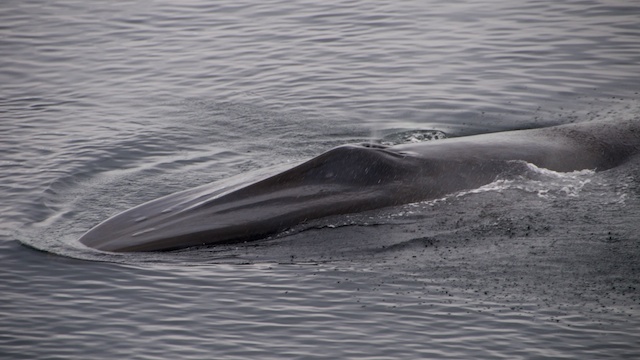
At the same time we had a report from Ulric, they has just seen two groups of orca passing close to the Wall Islets. This was their second morning at the outcamp and they were obvioulsy thrilled.

We wrapped up the day watching the sun slowly drop out of view to the west and the full moon rise over Princess Royal Island to the east… just another day in paradise.
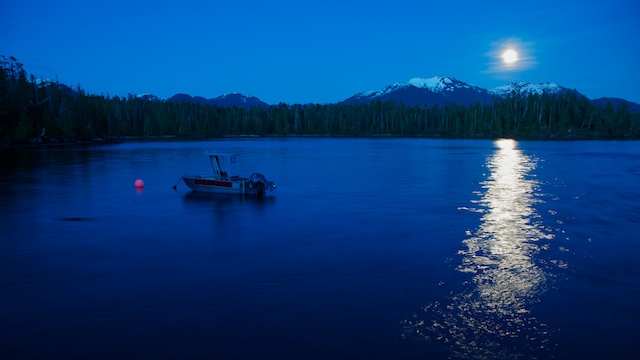

 Blog
Blog